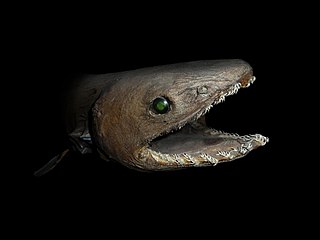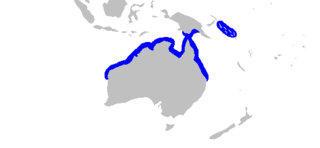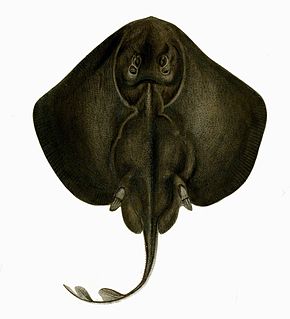
The frilled shark and the southern African frilled shark are the two extant species of shark in the family Chlamydoselachidae. The frilled shark is considered a living fossil, because of its primitive, anguilliform (eel-like) physical traits, such as a dark-brown color, amphistyly, and a 2.0 m (6.6 ft)–long body, which has dorsal, pelvic, and anal fins located towards the tail. The common name, frilled shark, derives from the fringed appearance of the six pairs of gill slits at the shark's throat.
Squalidae, also called dogfish sharks, dog sharks, or spiny dogfish, are a family of sharks in the order Squaliformes. Dogfish sharks make up the second largest order of sharks at 119 species. They have two dorsal fins, each with smooth spines, but no anal fin, and their skin is generally rough to the touch. Dogfish tend to have slender bodies with a pointed snout. These species are also known to be more compact in comparison to other sharks. As the species reaches adulthood, males usually measure a maximum of 39 inches (990 mm), while females typically measure 49 inches (1,200 mm) long. The species therefore exhibits female-dominant sexual dimorphism. Dogfish sharks earned their name after a group of fishermen observed the species chasing down smaller fish in dog-like packs.

The spiny dogfish, spurdog, mud shark or piked dogfish, is one of the best known species of the Squalidae (dogfish) family of sharks, which is part of the Squaliformes order. While these common names may apply to several species, Squalus acanthias is distinguished by two spines and no anal fin. It lives in shallow waters and further offshore in most parts of the world, especially in temperate waters. Those in the northern Pacific Ocean were reevaluated in 2010 and found to constitute a separate species, now called the Pacific spiny dogfish .
Squalus is a genus of dogfish sharks in the family Squalidae. Commonly known as spurdogs, these sharks are characterized by smooth dorsal fin spines, teeth in upper and lower jaws similar in size, caudal peduncle with lateral keels; upper precaudal pit usually present, and caudal fin without subterminal notch. In spurdogs, the hyomandibula is oriented at a right angle to the neurocranium, while in other sharks, the hyomandibula runs more parallel to the body. This led some to think that the upper jaw of Squalus would not be as protractile as the jaws of other sharks. However, a study that compared different jaw suspension types in sharks showed that this is not the case and that Squalus is quite capable of protruding its upper jaw during feeding.

The kitefin shark or seal shark is a species of squaliform shark in the family Dalatiidae, and the only species in its genus. It is found sporadically around the world, usually close to the sea floor at depths of 200–600 m (660–1,970 ft). With a sizable oil-filled liver to maintain neutral buoyancy, this shark is able to cruise slowly through the water while expending little energy. The kitefin shark, the largest luminous vertebrate on record, has a slender body with a very short, blunt snout, large eyes, and thick lips. Its teeth are highly differentiated between the upper and lower jaws, with the upper teeth small and narrow and the lower teeth large, triangular, and serrated. Its typical length is 1.0–1.4 m (3.3–4.6 ft), though examples as long as 5.9 ft (180 cm) have been encountered.

The mandarin dogfish is a dogfish, a member of the family Squalidae in the order Squaliformes. It is found at depths of 140–650 metres (460–2,130 ft) off southern Japan, Taiwan, and Indonesia. Populations off Australia and New Zealand were formerly included in this species, but in 2007 these were assigned to a new species, the southern mandarin dogfish. It is not clear which of these species is involved in other populations from the tropical West Pacific.

The nervous shark is a species of requiem shark, and part of the family Carcharhinidae, so named because of its timid behavior in regard to humans. It is common in shallow, coastal waters off northern Australia, Papua New Guinea, and the Solomon Islands. A small brownish or grayish shark typically measuring 1.0–1.3 m (3.3–4.3 ft) long, this species has a short, blunt snout, oval eyes, and a relatively large second dorsal fin. The leading margins of most fins are finely edged with black, and the lower caudal fin lobe is black-tipped.

The Portuguese dogfish or Portuguese shark, is a species of sleeper shark of the family Somniosidae. This globally distributed species has been reported down to a depth of 3,675 m (12,057 ft), making it the deepest-living shark known. It inhabits lower continental slopes and abyssal plains, usually staying near the bottom. Stocky and dark brown in color, the Portuguese dogfish can be distinguished from similar-looking species by the small spines in front of its dorsal fins. Its dermal denticles are also unusual, resembling the scales of a bony fish. This species typically reaches 0.9–1 m (3.0–3.3 ft) in length; sharks in the Mediterranean Sea are much smaller and have distinct depth and food preferences.

The blacktailed spurdog is a dogfish, a member of the family Squalidae, found around New Caledonia in the central Pacific Ocean, at depths from 320 to 320 m. Its length is up to 75 cm.

The shortspine spurdog is a dogfish, a member of the family Squalidae, found on continental shelves off Japan in temperate waters, from the surface to 950 m. Its length is up to 75 cm.

The velvet belly lanternshark is a species of dogfish shark in the family Etmopteridae. One of the most common deepwater sharks in the northeastern Atlantic Ocean, the velvet belly is found from Iceland and Norway to Gabon and South Africa at a depth of 20–2,490 m (66–8,169 ft). A small shark generally no more than 45 cm (18 in) long, the velvet belly is so named because its black underside is abruptly distinct from the brown coloration on the rest of its body. The body of this species is fairly stout, with a moderately long snout and tail, and very small gill slits. Like other lanternsharks, the velvet belly is bioluminescent, with light-emitting photophores forming a species-specific pattern over its flanks and abdomen. The ventral photophores are thought to function in counter-illumination, which camouflages the shark against predators and prey. The bioluminescent flank markings may play a role in intraspecific communication.

The dark shyshark or pretty happy is a species of catshark, belonging to the family Scyliorhinidae, endemic to the temperate waters off southern Namibia and western South Africa. It is benthic in nature and inhabits shallow, inshore waters and favors rocky reefs and kelp forests. Growing to 60 cm (24 in) long, this small, stocky shark has a wide, flattened head with a rounded snout and a large flap of skin extending from before the nostrils to the mouth. Its dorsal coloration is extremely variable and may feature black-edged orange to blackish saddles and/or white spots on a light brown to nearly black background.

The small-spotted catshark, also known as the sandy dogfish, lesser-spotted dogfish, rough-hound or morgay, is a catshark of the family Scyliorhinidae. It is found on the continental shelves and the uppermost continental slopes off the coasts of Norway and the British Isles south to Senegal and in the Mediterranean, between latitudes 63° N and 12° N. It can grow up to a length of 1 m, and it can weigh more than 2 kg (4.4 lb). It is found primarily over sandy, gravelly, or muddy bottoms from depths of a few metres down to 400 m. S. canicula is one of the most abundant elasmobranchs in the northeast Atlantic and Mediterranean Sea. The majority of the populations are stable in most areas.

The African sawtail catshark is a species of catshark, part of the family Scyliorhinidae. Demersal in nature, it is found at depths of 160–720 m (520–2,360 ft) off the western African coast from Morocco to South Africa. This slender species has a rather long, pointed snout, a series of dark saddles along the back and tail, and a prominent crest of enlarged dermal denticles along the upper edge of the caudal fin. Its maximum known length is 46 cm (18 in).

The brown lanternshark or bristled lanternshark is a little-known species of deep-sea dogfish shark in the family Etmopteridae. It is found off Japan and New Zealand, and possibly also South Africa and Australia, typically deeper than 300 m (980 ft). This species can be distinguished from other lanternsharks by its coloration, which is a uniform dark gray or brown without the ventral surface being much darker and clearly delineated from the rest of the body. The brown lanternshark feeds on small bony fishes, cephalopods, and crustaceans. Reproduction is ovoviviparous, with females giving birth to 9–18 young. An unusually high proportion of individuals in Suruga Bay are hermaphrodites, with both male and female characteristics.

The bighead spurdog is a rare and little-known species of dogfish shark in the family Squalidae. It is found in deep water south of New Caledonia, and over the Norfolk Ridge. Reaching at least 90 cm (35 in) in length, this stocky shark is brown above and light below, with a broad head and two dorsal fins with long spines. It is the only member of its genus with both one- and three-pointed dermal denticles. An infrequent bycatch of longline fisheries, this species is listed under Data Deficient by the International Union for Conservation of Nature (IUCN).
The Philippine spurdog or Indonesian greeneye spurdog, is a relatively large species of dogfish shark native to waters off the coast of Australia, the Philippines, and Indonesia. The species was identified in 1912 from a specimen caught off the coast of Luzon Island, and has been both bycatch and a targeted species in fisheries since. Its taxonomy is complex, having been renamed in 1931, being misidentified as a type of shortspine spurdog, then being revived as a species in 2007.

The Pacific spiny dogfish is a common species of the Squalidae (dogfish) family of sharks and are among the most abundant species of sharks in the world. This species is closely related to Squalus acanthias and for many years they were treated as a single species. Recent research, using meristic, morphological and molecular data led to the resurrection of Pacific Spiny Dogfish as a separate species. The American Fisheries Society recommends the common name "Pacific Spiny Dogfish" for Squalus suckleyi over alternatives such as "Spotted Spiny Dogfish" and "North Pacific Spiny Dogfish" and "Spiny Dogfish" for Squalus acanthias.
The greeneye spurdog is a species of dogfish described in 2007. It is a member of the family Squalidae, found off the coast of southeastern Australia. The length of the longest specimen measured is 85.6 cm (33.7 in). It was considered conspecific with the shortspine spurdog.

The rough ray is a Mediterranean ray species of the Rajidae family described by Delaroche in 1809.


















